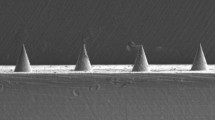Abstract
Microneedles are extremely small and minimally-invasive intradermal drug delivery devices that require controlled, accurate, and repeatable insertions into human skin to perform their functions. Due to high variability and elasticity of human skin, dynamic insertion methods are being sought to ensure success in microneedle insertions into the skin passed the tough stratum corneum layer. Dynamic microneedle insertions have not been thoroughly studied to identify and assess the key parameters influencing the skin fracture to date. Here, we have utilized a previously validated artificial mechanical human skin model to identify and evaluate the factors affecting microneedle insertion. It was determined that a microneedle’s velocity at impact against the skin played the most crucial role in successfully inserting microneedle devices of different geometrical features (i.e., tip area) and array size (i.e., number of projections). The findings presented herein will facilitate the development of automated microneedle insertion devices that will enable user-friendly and error-free applications of microneedle technologies for medicine delivery.







Similar content being viewed by others
References
S.P. Davis, B.J. Landis, Z.H. Adams, et al., J. Biomech. 37, 1155 (2004)
M. Yang, J.D. Zahn, Biomed. Microdevices 6, 177 (2004)
J.-H. Park, M.G. Allen, M.R. Prausnitz, J. Control. Release104, 51 (2005)
P. Khanna, K. Luongo, J.A. Strom, et al., J. Micromech. Microeng.20, 045011 (2010)
O. Olatunji, D.B. Das, M.J. Garland, et al., J. Pharm. Sci.102, 1209 (2013)
M. Geerligs, Technical Note PR-TN 450 (2006)
S.A. Ranamukhaarachchi, T. Schneider, S. Lehnert, et al., Macromol. Mater. Eng. 301, 306 (2016a)
A. Passot, G. Cabodevila, in Mechanical properties of an artificial vascularized human skin, (2011) (International Society for Optics and Photonics), p. 80680C
W. Koelmans, G. Krishnamoorthy, A. Heskamp, et al., Mech. Eng. Research 3, p51 (2013)
E. Larrañeta, J. Moore, E.M. Vicente-Pérez, et al., Int. J. Pharm.472, 65 (2014)
M.J. Garland, K. Migalska, T.-M. Tuan-Mahmood, et al., Int. J. Pharm. 434, 80 (2012)
D. Zhang, D.B. Das, C.D. Rielly, J. Pharm. Sci. 103, 613 (2014)
B. Chua, S.P. Desai, M.J. Tierney, et al., Sens. Actuators A Phys.203, 373 (2013)
I. Mansoor, Y. Liu, U. Häfeli, et al., J. Micromech. Microeng.23, 085011 (2013)
S. Ranamukhaarachchi, S. Lehnert, S. Ranamukhaarachchi, et al., Sci. Rep. 6 (2016b)
M. Heverly, P. Dupont, J. Triedman, in Trajectory optimization for dynamic needle insertion, 2005 (IEEE), p. 1646
Acknowledgements
The authors also thank the Vanier Canada Graduate Scholarship program, the Canadian Institute for Health Research, and the Natural Sciences and Engineering Research Council of Canada for financial contributions towards this research. This research was undertaken, in part, thanks to funding from the Canada Research Chairs program. The authors also thank Dr. Hasitha Jayathilake for his guidance on image processing for this study.
Author information
Authors and Affiliations
Corresponding author
Additional information
Publisher’s note
Springer Nature remains neutral with regard to jurisdictional claims in published maps and institutional affiliations.
Rights and permissions
About this article
Cite this article
Ranamukhaarachchi, S.A., Stoeber, B. Determining the factors affecting dynamic insertion of microneedles into skin. Biomed Microdevices 21, 100 (2019). https://doi.org/10.1007/s10544-019-0449-y
Published:
DOI: https://doi.org/10.1007/s10544-019-0449-y




